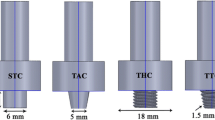Abstract
This paper aims at investigating effects of initial hardness on interfacial features for identical compositional materials under identical welding conditions. Two underwater explosive welding experiments on tool steel SKS3 with copper foil were carried out: one as-received and the other heat-treated. The welding process was simulated using the commercially available software package LS-DYNA. Numerical simulation gave deformation of the flyer/base plate and pressure distribution during the welding process. Microstructure and hardness at interface of the welded metals were evaluated. The results indicate that decreasing impact energy is accompanied by a shift from wavy to linear interface. Moreover, a comparison of the two experiments allows the conclusion that high initial hardness results in a decrease of wavelength and amplitude under identical welding conditions. Hardness profiles of as-received tool steel-copper welding reveal the hardening effect of impact in the vicinity of the interface. However, of interest is that a decrease in hardness was seen in the case of heat-treated martensitic tool steel with copper, fundamentally differing from previous explosive welding research; phase transition is proposed to discuss the relation between the effects of impact and heat, and those of work hardening and softening.












Similar content being viewed by others
References
S.A.A. Akbari-Mousavi and L.M. Barrett, Explosive Welding of Metal Plates, J. Mater. Process. Technol, 2008, 202, p 224
S.A.A. Akbari-Mousavi and P. Farhadi-Sartangi, Experimental Investigation of Explosive Welding of Cp-Titanium/AISI, 304 Stainless Steel, Mater. Des., 2009, 30, p 459
A. Durgutlu, B. Gulenc, and F. Findik, Examination of Copper/Stainless Steel Joints Formed by Explosive Welding, Mater. Des., 2005, 26, p 497–507
N. Kahraman, B. Gulenc, and F. Findik, Joining of Titanisum/Stainless Steel by Explosive Welding and Effect on Interface, J. Mater. Process. Technol., 2005, 169, p 127–133
H.R. Zareie Rajani and S.A.A. Akbari Mousavi, The Effect of Explosive Welding Parameters on Metallurgical and Mechanical Interfacial Features of Inconel 625/Plain Carbon Steel Bimetal Plate, Mater. Sci. Eng. A., 2012, 556, p 454–464
H. Iyama, A.K.M. Fujita, S. Kubota, K. Hokamoto, and S. Itoh, An Investigation on Underwater Explosive Bonding Process, J. Pressure Vessel. Technol., 2001, 123, p 486
K. Hokamoto, M. Fujia, H. Shimokawa, and H. Okugawa, A New Method for Explosive Welding of Al/ZrO2 Joint Using Regulated Underwater Shock Wave, J. Mater. Process. Technol., 1999, 85, p 175–179
K. Hokamoto, K. Nakata, A. Mori, S. Tsuda, T. Tsumura, and A. Inoue, Dissimilar Material Welding of Rapidly Solidified Foil and Stainless Steel Plate Using Underwater Explosive Welding Technique, J. Alloys Compd., 2009, 472, p 507–511
P. Manikandan, J.O. Lee, K. Mizumachi, A. Mori, K. Raghukandan, and K. Hokamoto, Underwater Explosive Welding of Thin Tungsten Foils and Copper, j. Nucl. Mater., 2011, 418, p 281
W. Sun, X. Li, H. Yan, and X. Wang, An alternative Thin-Plate Welding Technology Using Underwater Shock Wave, J. Adhes. Sci. Technol., 2012, 26, p 1733–1743
A. Das and S. Tarafder, Experimental Investigation on Martensitic Transformation and Fracture Morphologies of Austenitic Stainless Steel, Int. J. Plasticity, 2009, 25, p 2222–2247
H. Hallberg, P. Hakansson, and M. Ristinmaa, A Constitutive Model for the Formation of Martensite in Austenitic Steels Under Large Strain Plasticity, Int. J. Plasticity, 2007, 23, p 1213–1239
R. Zaera, J.A. Rodriguez-Martinez, A. Casado, J. Fernandez-Saez, A. Rusinek, and R. Pesci, A Constitutive Model for Analyzing Martensite Formation in Austenitic Steels Deformation at High Strain Rates, Int. J. Plasticity, 2012, 29, p 77–101
B. Fournier, M. Sauzay, and A. Pineau, Micromechanical Model of the High Temperature Cyclic Behavior of 9-12%Cr Martensitic Steels, Int. J. Plasticity, 2011, 27, p 1803–1816
V. Velay, G. Bernhant, and L. Penazzi, Cyclic Behavior Modeling of a Tempered Martensitic Hot Work Tool Steel, Int. J. Plasticity, 2006, 22, p 459–496
A.A. Deribas, V.A. Simonov, and I.D. Zakcharenko, Proceedings of 5th High Energy Rate Fabrication International Conference, Proceedings, Denver, 1975, p 1–24
Y.I. Oka, M. Matsumura, and T. Kawabata, Relationship Between Surface Hardness and Erosion Damage Caused by Solid Particle Impact, Wear, 1993, 162, p 688
R. Venkateswara, N. Madhusudhan-Reddy, and G.S. Nagarjuna, Weld Overlay Cladding of High Strength Low Alloy Steel with Austenitic Stainless Steel—Structure and Properties, Mater. Des., 2012, 32, p 496–2506
Acknowledgments
This research was financially supported by the Natural Science Foundation of China (10972051, 11272081) and China Scholarship Council (CSC).
Author information
Authors and Affiliations
Corresponding author
Rights and permissions
About this article
Cite this article
Sun, W., Li, X., Yan, H. et al. Effect of Initial Hardness on Interfacial Features in Underwater Explosive Welding of Tool Steel SKS3. J. of Materi Eng and Perform 23, 421–428 (2014). https://doi.org/10.1007/s11665-013-0778-6
Received:
Revised:
Published:
Issue Date:
DOI: https://doi.org/10.1007/s11665-013-0778-6




